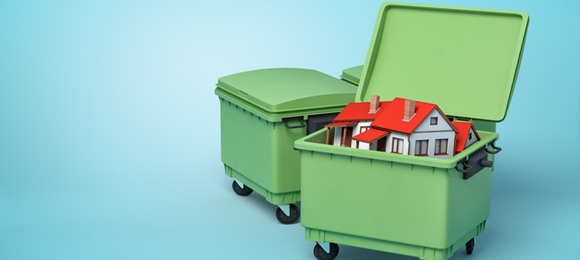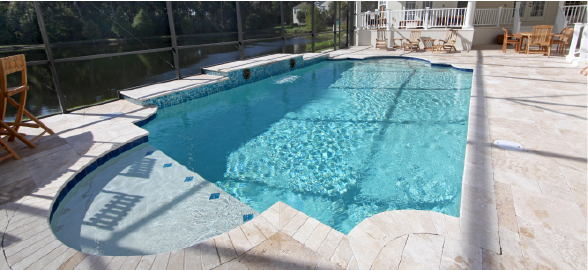
Updated August 31, 2022
Disposal of demolition debris is a major part of the cost of demolishing a home.
Getting a rough estimate of how many roll-off dumpsters you'll need for house demolition disposal makes it a lot easier to estimate the overall cost of demolition.
The number of dumpsters required to dispose of house demo debris will depend on the size of your home and the materials used to build it.
Here is a rough estimate of how many 40-yard dumpsters it will take to dispose of common-size houses that are stick-built...
| House Size | Amount of Debris | # of 40-yard Dumpsters |
|---|---|---|
| 1,000 sq. ft. | 135 cubic yards | 3.5 |
| 2,000 sq. ft. | 270 cubic yards | 6.75 |
| 3,000 sq. ft. | 405 cubic yards | 10.5 |
How many dumpsters do I need to demolish a 2,000 sq. ft. house?
To simplify things, we’re going to take a more detailed look at how many dumpsters a typical stick-built 2,000 sq. ft. house will require.
Because all houses are different, your exact results may vary considerably.
Factors that can impact the required number of dumpsters include whether the home was built with a wood exterior or brick, on a concrete slab or with a basement, deconstructed for reusable materials prior to demo, and more.
Demolishing a 2,000 sq. ft. house with a slab foundation will produce roughly 270 cubic yards of debris!

First, let's calculate how many cubic yards of C&D (construction and demolition) debris the home will have from materials like wood, siding, roofing, lathe or drywall, and other miscellaneous components making up the home.
Here, we are looking at only debris from the home. We're NOT including the concrete foundation and any tree canopy or green waste to remove. Those will be calculated separately.
Calculating the cubic yards of demolition debris is simple and involves converting the cubic footage of the structure to cubic yards while also accounting for the air space in the building (0.33).
For our 2,000 sq. ft. house example, let's assume our home is two (2) stories and the dimensions are 40 ft. x 25 ft. The formula and calculations are:
C&D debris, including wood, siding, roofing, drywall, etc.
(Length (ft) x Width (ft) x Height (ft) x 0.33) ÷ 27 = cubic yards of demolition debris
(40 ft L x 25 ft W x 20 ft H x 0.33) ÷ 27 = 244.4 cubic yards of debris
To get the number of dumpsters needed for this portion of the debris, we divide our roughly 245 cubic yards of debris by the cubic yard capacity of the dumpster.
245 cubic yards of debris / 30 cubic yard dumpster = 8 dumpsters
245 cubic yards of debris / 40 cubic yard dumpster = 6 dumpsters
For the C&D debris on our example 2,000 sq. ft. house, you would likely need eight to nine 30 yard dumpster loads or six to seven 40 yard dumpster loads. This does NOT include dumpsters for the concrete foundation or green waste.
Learn more about renting dumpsters as a contractor: Contractor's Guide to Renting a Dumpster for Large Construction or Demolition Jobs
How many dumpsters are needed for the concrete foundation debris?
The number of dumpsters needed for the concrete foundation should be calculated separately. The concrete needs to be in separate loads.
A 'clean concrete' load (dumpster containing only concrete) can be dumped at the concrete recycler rather than the landfill, so don't mix other debris in with the concrete.
Some landfills will not accept concrete, and dumping concrete at a recycler is generally much cheaper than the cost to dump at a landfill.
The average foundation is somewhere between 8 and 10 inches thick.
For our example, we'll assume 8 inches (.67 ft) and that our 2,000 sq. ft. home was built on a slab. If you have a basement or crawl space, you'll need to calculate the floor and the four concrete walls separately (same formula for each section), and then add it all together.
Concrete slab foundation
(Length (ft) x Width (ft) x Height (ft)) ÷ 27 = cubic yards of debris
(40 ft L x 25 ft W x 0.67 ft H) ÷ 27 = 24.8 cubic yards of concrete debris
Because concrete is so heavy, you won't be able to fill up a single 30 yard dumpster with 25 cubic yards of concrete. The concrete debris will weigh over 50 tons, and the hauler will never be able to pull the dumpster up onto the truck. It's just too heavy.
There are also weight restrictions on the roads that would be problematic.
Concrete weighs about 4,000 lbs per cubic yard. So, in our example... roughly 25 cubic yards of concrete debris x 4,000 lbs/cubic yard = 100,000 lbs or 50 tons of concrete.
Dumpster rental companies' ability to pick up and haul very heavy loads of concrete varies considerably, so be sure to ask your hauler about the capabilities of their truck and hook lift system that pulls the dumpster up onto the truck.
A 40 ft. x 30 ft. concrete slab foundation that is 8 inches thick would produce 50 tons of concrete to remove. At least fourteen 10 - 20 yard dumpsters would be required, depending on their weight limit.
Read more:
- How Much Does It Cost to Rent a Concrete Dumpster?
- A Comprehensive Guide to Dumpster Weight Limits
- Demolition Safety 101: How to Be Sure Your Demolition Project Runs Smoothly and Safely
Find a house demolition contractor near you
Account for any green waste to be removed

If your home is surrounded by trees that will need to be removed prior to demolition, this is something that you’ll need to take into account.
Generally speaking, the best way to handle tree removal is to hire a tree removal specialist prior to demolition. They will then haul off the yard waste or convert the wood to chips on-site.
If the demolition provider will be removing any nearby trees or yard waste during the demolition process, you will need to include this in your estimates for cubic yards of debris and the total number of dumpsters necessary to haul it away.
A common way to do this is by using what’s called a vegetative cover multiplier (VCM). Developed by FEMA, it accommodates for the vegetative debris, or green waste, that will be included in the demolition of a home within a subdivision or neighborhood.
- For new home developments where more ground is visible than trees and canopy cover is thin, VCM = 1.1
- For homes that have an equal amount of open space and canopy cover, VCM = 1.3 (Most common)
- For homes found in mature neighborhoods or the canopy cover completely covers the ground/home, VCM = 1.5
So, if your home has thin canopy coverage, multiply the total cubic yards of debris by 1.1. If canopy coverage is average, multiply the total cubic yards by 1.3; and multiply by 1.5 if coverage is thick.
TIP: If you're not using a tree removal company, double-check that the dumpster service will haul green waste. Most will... but green waste generally can't be mixed with other types of waste. The entire load must be a 'clean load' of only yard waste...no general trash or other demo debris.
Weight limits can greatly affect the price of disposal
Dumpsters—and the trucks that haul them away—have weight limits.
Wood, lathe, concrete, and other demolition debris is very heavy. So, when comparing pricing from dumpster services, consider the amount of included weight for the price.
The more generous the weight allowance, the lower your overall disposal cost will be.
The chart below can help you roughly understand the weight of common types of demolition debris per cubic yard.
| Material | Lbs/Cubic yd | Notes |
| Burned debris/ash | 800 - 1,000 1,500 - 1,800 2,300 | Loose/dry Wet for dust suppression Wet mixed with soil |
| Asphalt or concrete | 2,400 | |
| Wood, un-compacted | 400 | Increase up to 100% if compacted using heavy machinery |
| Metals, un-compacted | 600 | Ex. appliances, metal siding |
| Earth | 2,100 3,000 |
Loose/dry. Increase 30% if compacted
Excavated/wet |
| Gravel or crushed stone | 2,600 | Increase 20% if wet |
| Standard red clay bricks | 3,400 |
Here are some examples of 'included weight' for general construction debris:*
- 10 yard dumpsters: 2,000 - 4,000 lbs / 1 - 2 tons
- 20 yard dumpsters: 4,000 - 6,000 lbs / 2 - 3 tons
- 30 yard dumpsters: 8,000 - 10,000 lbs / 4 - 5 tons
- 40 yard dumpsters: 12,000 - 16,000 lbs / 6 - 8 tons
* These are examples of included weight. Each company's weight limits are different, so be sure to check with your dumpster provider. And know what happens when your dumpster exceeds the weight limit. What is the additional cost per ton of additional weight?
Call ahead to discuss dumpster provider's availability.
For any significant demolition project, the hired dumpster service will need to be available for multiple trips back and forth to the landfill or recycling center.
The dumpster company will deliver a container (or more in some cases) to the site of your intended demolition.
You then fill up the dumpster, and the company loads it onto their truck, hauls it to the landfill/recycling facility, empties the container, and brings it back to the demo site, repeating this process until all the debris is gone.
Plan ahead so the dumpster company can dedicate a truck or two to your job for part or all of a day.

Calculating exactly how many dumpsters you'll need for a home demolition is a bit of an art, and the answer is different for every project.
Find a house demolition contractor near you
Learn more about hiring the right contractor:


